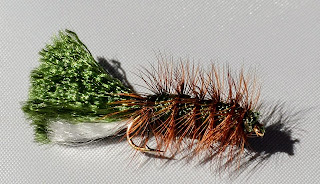May
Fly Tying Forum
By
Brian Garringer
The May fly tying forum at the John
E. Pechmann Center, in Fayetteville NC, was lead by two of the Project Healing
Water Fly Fishing volunteers, Craig Person and Terrance Straiter.
Craig started the session with
a terrestrial pattern. This pattern was
a bee. While the pattern itself was simple,
there were some new skills required to complete it. It started out as many craft foam pattern do
by tying the foam to the top of the hook.
It then moves to using CDC as dubbing.
He split the thread and inserted the CDC fibers in the opening. This can be even more difficult than it
sounds. First, to split the thread,
spins it counterclockwise. This loosens
the individual fibers that make the thread.
A fingernail or a bodkin can be inserted between the threads to create
an opening in the thread.
Splitting
the thread is only half off the battle; you also have to get the CDC into the
open in the thread. This can be done is
two way. One way is to prep the CDC
feather prior to splitting the thread. Place
a large binder clip on the edge of the CDC fibers. Then trim the fibers off the stem of the
feather. The clip will hold the fibers
in place until they are needed. The CDC
fibers can be set aside until the thread is ready. Once the thread is split and the CDC Fibers
are inserted then the thread is pulled down to place tension on the fibers. The tension will hold the fibers and the clip
can be removed.
The
other way does not require any prepping.
The thread is split and the CDC fibers are inserted into the opening
still on the stem. The thread is pulled
down with one hand to place tension on the fibers to hold them in place. With the other hand, the stem is trimmed away
the fibers. Once the CDC Fibers are
inserted in the thread, it is then spun to close the opening and turn the
fibers in all directions. Once the
thread has been spun, the CDC is trapped in the thread. It is then ready to be wrapped, as normal
dubbing would be.
This
technique creates less bulk then a standard dubbing loop. The dubbing loop is created by doubling
thread over. The fibers are then
inserted between the two pieces of thread.
It can then be spun and the fibers would be trapped in the thread While it is easier in technique and not as
time consuming to prepare. It uses twice
the thread. In small to ultra small
flies this added bulk that can be anywhere from a nuance to a disaster.
The
second fly of the evening was a Modified Woolly Bugger taught by Terrence
Straiter. This fly was modified to all
natural fibers. Terence traded the chenille
that was normally used to form the body for all natural materials. He used two different materials to form the
body. The first was white fisherman’s
wool yarn. This was tied in and wrapped
just as the chenille would be.
The
second material was alpaca fur. An
alpaca is am animal that is similar to a lama.
Its fur is harvested and used to make wool. For the body Terence used loosed fur it was
applied to thread as a dubbing.
In
addition to the wool and alpaca bodies, he also changed the bead. Many manufactures of flies will place a bead
to provide additional weight and flash.
He placed a glass bead to provide flash.
These
two flies were well taught and provided a success evening if fly tying. Fly trying forums are held on the fourth Thursday
of the month. Check out the this programs and others at the
John E. Pechmann Fishing Education Center website. http://www.ncwildlife.org/Learning/EducationCenters/Pechmann/EventRegistration.aspx.

